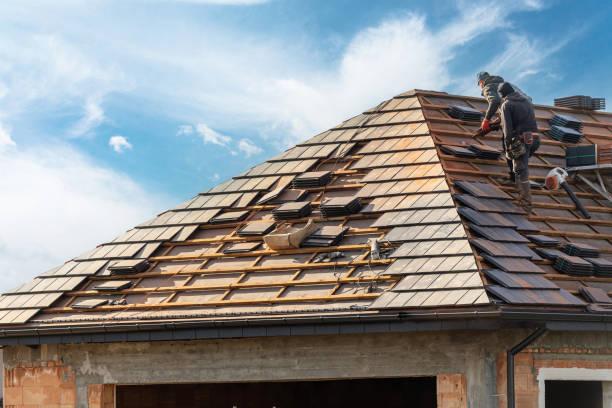What Should Homeowners Expect During a Roof Replacement?

A roof replacement is one of the biggest home improvement projects a homeowner will face. Beyond enhancing curb appeal, it ensures long-term protection against leaks, weather, and structural issues. Many people, however, feel overwhelmed by the process because they don’t know what to expect. From choosing materials to preparing for noise and debris, having a clear understanding makes the experience smoother and less stressful.
In Watertown, SD, where homes face harsh winters and stormy summers, a durable and well-installed roof is essential for year-round safety. This guide walks you through every stage of the replacement process so you can plan confidently.
Steps in a Roof Replacement
Step 1: Initial Roof Inspection and Estimate
The process begins with a professional roof inspection. Contractors assess your current roof’s condition, identify leaks, evaluate ventilation, and determine whether repairs or full replacement are necessary. After the inspection, you’ll receive a detailed estimate outlining labor, materials, and projected timelines.
Step 2: Choosing Roofing Materials
The material you choose directly impacts durability, aesthetics, and cost. Common options include asphalt shingles, metal roofing, wood shakes, slate, and synthetic alternatives. Asphalt remains the most affordable, while metal and slate provide superior longevity. During this stage, you’ll weigh pros and cons, factoring in climate conditions, budget, and your home’s architectural style.
Step 3: Preparing Your Property
Before the roof replacement begins, contractors take steps to protect your property. Tarps are placed over landscaping, siding, and outdoor furniture. You may need to move vehicles from the driveway to allow access for dumpsters and material deliveries. Inside the home, it’s wise to secure fragile items since vibrations from roof work can cause them to shift.
Step 4: Removing the Old Roof
The existing roof is carefully torn off, section by section. This step can be noisy and messy, but it’s necessary for a solid new installation. Contractors will dispose of old shingles, nails, and underlayment using dumpsters or hauling services. In most cases, tear-off takes one to two days, depending on roof size and complexity.
Step 5: Inspecting the Roof Deck
Once the old roofing is removed, the roof deck is inspected for rot, mold, or structural weaknesses. Any compromised decking is replaced before installation continues. This ensures your new roof has a strong foundation and prevents future leaks.
Step 6: Installing Underlayment and Flashing
A moisture barrier, usually synthetic underlayment, is applied to the decking to protect against water infiltration. Flashing is then installed around chimneys, valleys, and vents to seal vulnerable areas. These layers are critical for preventing leaks and improving energy efficiency.
Step 7: Installing the New Roof
With preparation complete, contractors begin installing the new roofing material. This phase involves laying shingles, metal panels, or tiles in precise alignment. Attention to detail is key to ensuring durability, weather resistance, and aesthetic appeal. Depending on the material and roof size, installation can take several days.
Step 8: Cleanup and Final Inspection
After installation, crews remove debris, stray nails, and unused materials from your property. Many contractors use magnetic sweepers to ensure no nails are left behind. A final inspection is conducted to verify proper installation and address any concerns. You’ll receive warranty details and maintenance tips to maximize the life of your new roof.
How Long Does a Roof Replacement Take?
Most residential roof replacements take 2 to 5 days, though larger or more complex projects may take longer. Weather conditions can also impact the timeline. Planning during favorable seasons helps avoid delays.
Preparing for Life During the Project
Roof replacement can be disruptive. Expect loud noise from hammering and machinery. Pets may feel stressed, and young children might need alternative arrangements during installation. Clear communication with your contractor ensures you know when crews will arrive and how long the workday will last.
Conclusion
A roof replacement may seem daunting, but knowing what to expect makes the process far less stressful. From inspection to final cleanup, each stage plays a role in protecting your home for decades to come. For professional guidance and seamless project execution, New Horizons Roofing & Gutters LLC offers the expertise and reliability you can count on.
FAQs
1. How do I know if I need a roof replacement instead of repairs?
If your roof is over 20 years old, shows widespread shingle damage, or has recurring leaks, replacement is usually the better option.
2. How much does a roof replacement cost?
Costs vary by material and home size, but most homeowners spend between $8,000 and $20,000 for a complete replacement.
3. Can I stay home during roof replacement?
Yes, but expect noise and vibrations. If you work from home or have small children, you may prefer to spend time elsewhere during the project.
4. What season is best for roof replacement?
Spring and summer are ideal since weather conditions are more stable, reducing the risk of delays.
5. How long will my new roof last?
Lifespan depends on material: asphalt shingles last 20–30 years, while metal or slate can last 50 years or more with proper maintenance.
- Roof_Replacement
- Roofing
- Roof_Inspection
- Roof_Decking
- Roofing_Materials
- Asphalt_Shingles
- Metal_Roofing
- Roof_Installation
- Roof_Tear-Off
- Roof_Underlayment
- Roof_Flashing
- Roofing_Costs
- Roofing_Guide
- Residential_Roofing
- Roofing_Contractor
- Roof_Maintenance
- Roofing_Process
- Roof_Warranty
- Roof_Repair_vs_Replacement
- Durable_Roofing
- Art
- Causes
- Crafts
- Dance
- Drinks
- Film
- Fitness
- Food
- Games
- Gardening
- Health
- Home
- Literature
- Music
- Networking
- Other
- Party
- Religion
- Shopping
- Sports
- Theater
- Wellness


